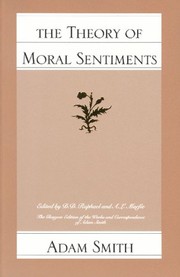Check nearby libraries
Buy this book

The Theory of Moral Sentiments, Smith’s first and in his own mind most important work, outlines his view of proper conduct and the institutions and sentiments that make men virtuous. Here he develops his doctrine of the impartial spectator, whose hypothetical disinterested judgment we must use to distinguish right from wrong in any given situation. We by nature pursue our self-interest, according to Smith. This makes independence or self-command an instinctive good, and neutral rules as difficult to craft as they are necessary. But society is not held together merely by neutral rules; it is held together by sympathy. Smith argues that we naturally share the emotions and to a certain extent the physical sensations we witness in others. Sharing the sensations of our fellows, we seek to maximize their pleasures and minimize their pains so that we may share in their joys and enjoy their expressions of affection and approval. - Publisher.
Check nearby libraries
Buy this book

Previews available in: English
Showing 6 featured editions. View all 44 editions?
| Edition | Availability |
|---|---|
| 1 |
zzzz
Libraries near you:
WorldCat
|
| 2 |
zzzz
Libraries near you:
WorldCat
|
| 3 |
aaaa
Libraries near you:
WorldCat
|
| 4 |
eeee
|
|
5
The theory of moral sentiments: or, An essay towards an analysis of the principles by which men naturally judge concerning the conduct and character, first of their neighbours, and afterward of themselves. To which is added, a dissertation on the origin of languages
1809, R. Chapman
in English
- 12th ed. Enriched with a portrait and life of the author.
|
bbbb
Libraries near you:
WorldCat
|
|
6
The theory of moral sentiments: or, An essay towards an analysis of the principles by which men naturally judge concerning the conduct and character, first of their neighbours, and afterwards of themselves.
1801, Printed by A. Strahan, for T. Cadell [and others]
- 9th ed.
|
bbbb
Libraries near you:
WorldCat
|
Book Details
Table of Contents
Edition Notes
Includes bibliographical references and index.
Reprint. Originally published: Oxford : Clarendon Press ; New York : Oxford University Press, 1976.
Classifications
The Physical Object
ID Numbers
Community Reviews (0)
Feedback?History
- Created April 1, 2008
- 10 revisions
Wikipedia citation
×CloseCopy and paste this code into your Wikipedia page. Need help?
| August 15, 2017 | Edited by Bryan Tyson | Edited without comment. |
| August 15, 2017 | Edited by Bryan Tyson | Edited without comment. |
| August 4, 2017 | Edited by Bryan Tyson | Edited without comment. |
| August 4, 2017 | Edited by Bryan Tyson | Added new cover |
| April 1, 2008 | Created by an anonymous user | Imported from Scriblio MARC record |

















